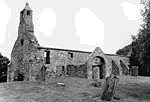|
|
|
|
|
Travel To Flisk Parish In North Fife, Scotland
Fliskmillan, or more correctly " Fliskmullan, " never had a mill; but the name does describe accurately the round, bald ridge, now covered, which forms a buttress to the cairn-topped peak of Norman's Law to its rear. There are so many wonderful names and intriguing in this area. Lyndemus, Pittachop, Whirly Kip, Craigsimmie, Craiglug and Drumnod to name but a few. The old Balmerino scribes who wandered through this area must have had great difficulty in interpreting the ancient names like, Craigengrugiefauld and Cleikamscleuch; or at least as with that of Balmerino Abbey itself, they spelt them in many different ways. Even the sandbanks and shore rocks on the nearby River Tay have unusual and interesting names; Sure-as-Death, Eppies-Taes, Durward's Scalp, and farther east, Pluck-the-Craw.
Every name in and behind these hills has its own tale, and many noble, and not so noble things, have been plotted below, or in sight of, Norman's Law. The Mount of Sir David Lyndesay, the first of ten Lord Lyons that sprang from this side of Fife, is not far away on the slope of Lindiferronhill, easily seen by the Hopetoun Monument on its crest. Myrecairnie and Murdochcairnie are names that suggest tragedy -
Seek yonder brake beneath the cliff;
There lise Red Murdoch, stark and stiff
There was also young Ayton of Inchdairnie, on the way to visit his kin at Murdochcairnie, shot by Royalist Dragoons. It was not far from here that Crichton of Bottomcraig, in 1619, encountered his enemy. Fyfe of Crichton, who ran him through the body and was never seen again. Murdoch, Duke of Albany, was the owner of much of this land, the inheritance of the old Thanes of Fife, until his forfeiture and execution in the days of James I of Scotland.
Here are some Flisk Parish notes from A historic gazeteer of the counties of Fife, Kinross & Clackmannan, M Barbieri, published in 1857.
" Flisk parish is bounded on the north by the Tay, on the south by Creich and Abdie, on the east by Balmerino and on the west by Dunbog. It is 4 miles in length from east to west and 1 mile in breadth. Area 3.5 square miles; under cultivation 2210 acres; under pasture 140 acres; under wood 266 acres. Occupying the northern slope of the Ochils, a considerable portion of its surface is hilly and irregular, except about mile from the river, where it is level ground along the whole extent of the parish: the hills are Lyndemus, nearly 750 feet above sea level, Logie Law and Glenduckie Hill. With the exception of the Tay, the parish is watered by small burns and supplied by innumerable springs of the finest water.
The soil for the most part is a clayey loam, varying from 1 to 3 feet in depth, lying on rock, clay and till; the whole is nevertheless fertile, and the land is found cultivated from the shore of the Tay to the summit of the hills. Much has been done by draining land naturally wet; till lately stone draining was chiefly used, but now tile-draining is introduced. A mixture of 1 part of bone-dust to 2 parts of coal ashes is much used for turnips on the hill lands; wheat, barley, and oats, with potatoes, turnips, peas and beans are grown in the proportion of the order given here; the Fifeshire breed of cattle crossed with the Forfarshire is the kind kept; there are few sheep kept, owing to the hardness of the soil not being favourable to grass; there are eight thrashing mills; there is a great deficiency of cottages in this parish, which is the cause of the continued decrease of population. There are 3 heritors. Coals have to be brought from Newburgh or Balmerino or the Balbirnie pit. There are 3 quarries of sandstone and clinkstone; none of them of importance, and only used for local purposes. The parish being entirely a rural one, there are no manufactures carried on within it. The patron is the Earl of Zetland. There is no Dissenting place of worship. Parish school only. There are no fairs nor public houses in the parish. The nearest towns are Newburgh 6 miles, Cupar 8 miles and Dundee 10 miles. There is a post office at Newburgh, but the post town is Cupar. There is no village but the farm of Glenduckie, consists of a dozen cottages."
If you would like to visit this area as part of a highly personalized small group tour of my native Scotland please:
e-mail me today
Or why not visit my extensive
Travel Scotland
Web site at:
Travel Scotland
Home Page
|
|
|
|
|

